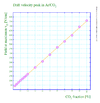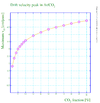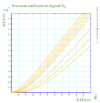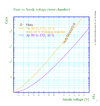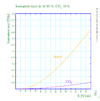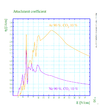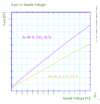Difference between revisions of "Why Garfield"
(Created page with "===Why 90/10 Ar/CO2 Mixture and why Garfield <ref name="Veenhof"/>=== ;why Garfield Garfield is the most commonly used by CERN for simulating the gaseous detectors. It contains …") |
|||
| Line 1: | Line 1: | ||
===Why 90/10 Ar/CO2 Mixture and why Garfield <ref name="Veenhof"/>=== | ===Why 90/10 Ar/CO2 Mixture and why Garfield <ref name="Veenhof"/>=== | ||
| + | ;why Garfield | ||
| + | |||
| + | Garfield is the most commonly used by CERN for simulating the gaseous detectors. It contains two other software packages: | ||
| + | |||
| + | - HEED (high energy electrodynamics):it is used for Estimating the number of electrons produced by ionization for an incident particle (a charged particle in our case). HEED uses PAI model (Photoabsorption ionization)which describes the relationship between the energy deposited by the charged particle and the photoabsorption cross section of the gas atom "not with a single electron or particular atomic shell" to simulate the initial ionization. HEED considers the cross section for individual shells of the atom or the molecules that build the gaseous medium. <ref name="Smirnov"> NIM A 554 2005 474-493</ref> | ||
| + | |||
| + | - Magboltz: It provides an accurately calculated drift velocity for the electron, it considers the existence of the electric field and the magnetic field, the solution for the transport equation to more than two terms, Lengo and Capitelli technique that allows using the the elastic and inelastic collisions using the momentum transfer inelastic cross section, isotropic foraward and backward scattering using the random numbers, | ||
| + | |||
| + | * Drift velocity: Increasing the percentage of CO2 the gas mixture at low electric field increases the drift velocity as shown in the figure: | ||
| + | |||
| + | [[File:drift_velocity_percentage_CO2_inAr.png || 100px]] | ||
| + | |||
| + | |||
| + | The drift velocity is saturated but at different values depending the percentage of the CO2, so the increase in the drift velocity becomes smaller withe increase in CO2 percentage int he gas mixture as show in the figures below: | ||
| + | |||
| + | [[File:max_drift_velocity_CO2percent_Efieldvalue.png || 100px]] [[File:Vmax_CO2percent.png || 100px]] | ||
| + | |||
| + | |||
| + | *Gain: It is dependent on Townsend coefficient, the figure below shows the gain-Electric field relationship for different mixtures of ArCO2, in addition to the effect penning of the gain. | ||
| + | |||
| + | [[File:Townsend_coeffiecient_inArCO2.png || 100px]] | ||
| + | |||
| + | The figure above is not accurate enough since Garfield and Magboltz software packages use the first two terms of Legendre polynomials as solution for Boltzmann transport equation (Magboltz may extend to the third term when the simulation goes in the longer time one), but using using IMonte 4.5 uses the spherical harmonics which improved the simulation and make independent of the expansions that describe the electron energy distribution. <ref name="Biagi"> S.Biagi Nucl. Instrum. Methods, vol. A 421, pp. 234–240, 1999</ref > | ||
| + | |||
| + | The effect of Penning on Townsend coefficient is represented by the following :===Why 90/10 Ar/CO2 Mixture and why Garfield <ref name="Veenhof"/>=== | ||
;why Garfield | ;why Garfield | ||
| Line 25: | Line 50: | ||
The effect of Penning on Townsend coefficient is represented by the following : | The effect of Penning on Townsend coefficient is represented by the following : | ||
| + | |||
| + | [[File:Townsend_coefficient_inArCO2_Penning.png || 100px]] | ||
| + | |||
| + | Comparing Ne/CO2 with Ar/CO2 considering the 40 percent of Penning transfer: | ||
| + | |||
| + | [[File:gain_NeCO2_ArCO2_full_40percent_penning_transfer.png || 100px]] | ||
| + | |||
| + | *Ionization rate: | ||
| + | |||
| + | [[File:ArCO2_ionization_rate.png || 100px]] | ||
| + | |||
| + | *Attachment: | ||
| + | |||
| + | [[File:ArCO2_attachment_Efieldvalue.png || 100px]] [[File:ArCO2_attachment_losspercent_anodevoltage.png || 100px]] | ||
| + | |||
| + | <references/> | ||
[[File:Townsend_coefficient_inArCO2_Penning.png || 100px]] | [[File:Townsend_coefficient_inArCO2_Penning.png || 100px]] | ||
Revision as of 13:13, 14 August 2013
Why 90/10 Ar/CO2 Mixture and why Garfield <ref name="Veenhof"/>
- why Garfield
Garfield is the most commonly used by CERN for simulating the gaseous detectors. It contains two other software packages:
- HEED (high energy electrodynamics):it is used for Estimating the number of electrons produced by ionization for an incident particle (a charged particle in our case). HEED uses PAI model (Photoabsorption ionization)which describes the relationship between the energy deposited by the charged particle and the photoabsorption cross section of the gas atom "not with a single electron or particular atomic shell" to simulate the initial ionization. HEED considers the cross section for individual shells of the atom or the molecules that build the gaseous medium. <ref name="Smirnov"> NIM A 554 2005 474-493</ref>
- Magboltz: It provides an accurately calculated drift velocity for the electron, it considers the existence of the electric field and the magnetic field, the solution for the transport equation to more than two terms, Lengo and Capitelli technique that allows using the the elastic and inelastic collisions using the momentum transfer inelastic cross section, isotropic foraward and backward scattering using the random numbers,
- Drift velocity: Increasing the percentage of CO2 the gas mixture at low electric field increases the drift velocity as shown in the figure:
The drift velocity is saturated but at different values depending the percentage of the CO2, so the increase in the drift velocity becomes smaller withe increase in CO2 percentage int he gas mixture as show in the figures below:
- Gain: It is dependent on Townsend coefficient, the figure below shows the gain-Electric field relationship for different mixtures of ArCO2, in addition to the effect penning of the gain.
The figure above is not accurate enough since Garfield and Magboltz software packages use the first two terms of Legendre polynomials as solution for Boltzmann transport equation (Magboltz may extend to the third term when the simulation goes in the longer time one), but using using IMonte 4.5 uses the spherical harmonics which improved the simulation and make independent of the expansions that describe the electron energy distribution. <ref name="Biagi"> S.Biagi Nucl. Instrum. Methods, vol. A 421, pp. 234–240, 1999</ref >
The effect of Penning on Townsend coefficient is represented by the following :===Why 90/10 Ar/CO2 Mixture and why Garfield <ref name="Veenhof"/>===
- why Garfield
Garfield is the most commonly used by CERN for simulating the gaseous detectors. It contains two other software packages:
- HEED (high energy electrodynamics):it is used for Estimating the number of electrons produced by ionization for an incident particle (a charged particle in our case). HEED uses PAI model (Photoabsorption ionization)which describes the relationship between the energy deposited by the charged particle and the photoabsorption cross section of the gas atom "not with a single electron or particular atomic shell" to simulate the initial ionization. HEED considers the cross section for individual shells of the atom or the molecules that build the gaseous medium. <ref name="Smirnov"> NIM A 554 2005 474-493</ref>
- Magboltz: It provides an accurately calculated drift velocity for the electron, it considers the existence of the electric field and the magnetic field, the solution for the transport equation to more than two terms, Lengo and Capitelli technique that allows using the the elastic and inelastic collisions using the momentum transfer inelastic cross section, isotropic foraward and backward scattering using the random numbers,
- Drift velocity: Increasing the percentage of CO2 the gas mixture at low electric field increases the drift velocity as shown in the figure:
The drift velocity is saturated but at different values depending the percentage of the CO2, so the increase in the drift velocity becomes smaller withe increase in CO2 percentage int he gas mixture as show in the figures below:
- Gain: It is dependent on Townsend coefficient, the figure below shows the gain-Electric field relationship for different mixtures of ArCO2, in addition to the effect penning of the gain.
The figure above is not accurate enough since Garfield and Magboltz software packages use the first two terms of Legendre polynomials as solution for Boltzmann transport equation (Magboltz may extend to the third term when the simulation goes in the longer time one), but using using IMonte 4.5 uses the spherical harmonics which improved the simulation and make independent of the expansions that describe the electron energy distribution. <ref name="Biagi"> S.Biagi Nucl. Instrum. Methods, vol. A 421, pp. 234–240, 1999</ref >
The effect of Penning on Townsend coefficient is represented by the following :
Comparing Ne/CO2 with Ar/CO2 considering the 40 percent of Penning transfer:
- Ionization rate:
- Attachment:
<references/>
Comparing Ne/CO2 with Ar/CO2 considering the 40 percent of Penning transfer:
- Ionization rate:
- Attachment:

